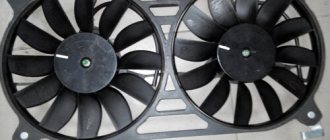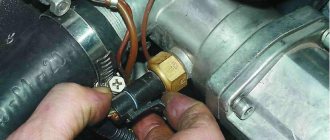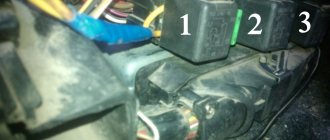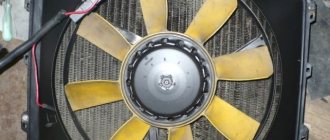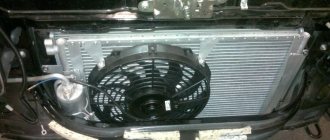Internal combustion engines are far from perfect, so most of the energy consumed during the operation of such units is released in the form of heat. In the winter season, this “by-product” can be successfully used to maintain optimal air temperature in the cabin, but in the summer this is not necessary, so antifreeze can boil even after a short period of operation of the internal combustion engine. When the coolant heats up to a certain value, the fan automatically turns on and the coolant temperature returns to normal. The VAZ 2110 fan switch-on sensor, with the help of which the forced cooling of the internal combustion engine is timely activated, will be discussed in this article.
Design and principle of operation
The VAZ 2110 fan sensor, both 8 and 16 valves, consists of a sealed housing, inside of which there is a bimetallic plate and electrical contacts. A feature of the working element is the possibility of significant physical expansion when heated. When the temperature changes significantly upward, the plate expands and the thermal relay contacts close.
On the outside of the housing, a thread is cut, which is necessary for reliable fixation of the sensor in the cooling system of the internal combustion engine. On the opposite side of the sensor, terminals are installed that are necessary for connecting the contact wires.
Replacing the fan switch sensor on the “ten”
Timely replacement of the VAZ 2110 fan switch sensor is carried out using an ordinary set of plumbing tools.
Replacement procedure:
- Drain the coolant from the radiator and disconnect the fan switch sensor.
- Remove the device from the radiator housing.
- Install a new device with a copper sealing ring.
Before installing the product, it is necessary to connect the terminals of a megger to the terminals of the output contact on the sensor for turning on the VAZ fan. This is how the functionality of the product is tested.
You can control the inclusion of a working product using heated water, where the sensor should be placed. In this case, the contact terminals of the device should close. At a temperature of about 95 degrees Celsius, the megohmmeter should show the resistance of the product, which will indicate the serviceability of the product.
Internal combustion engines are far from perfect, so most of the energy consumed during the operation of such units is released in the form of heat. In the winter season, this “by-product” can be successfully used to maintain optimal air temperature in the cabin, but in the summer this is not necessary, so antifreeze can boil even after a short period of operation of the internal combustion engine. When the coolant heats up to a certain value, the fan automatically turns on and the coolant temperature returns to normal. The VAZ 2110 fan switch-on sensor, with the help of which the forced cooling of the internal combustion engine is timely activated, will be discussed in this article.
Symptoms of a problem
If the engine boils, and the characteristic hum of the cooling system fan is not heard, then with a high degree of probability one can suspect the presence of a malfunction of the internal combustion engine. The opposite situation, when forced cooling operates as long as the ignition is on, will also indicate a problem with the automation. On a VAZ 2110 injector, a constantly switched on fan sensor may indicate problems with the controller. The control unit could “remember” an error that appeared earlier and, as a result, the electric motor is activated every time it is started.
Periodic turning on and off of the fan when the engine is not yet warmed up is also a sure sign of an imminent failure of the combustion engine.
Operation of the cooling fan in fuel-injected cars
The operation of the fan unit for cooling the temperature in injection engines is assigned to an electronic motor controller. Its software is configured to trigger the engine overheat protection system in the temperature range from 100 to 105 degrees Celsius. If a defect occurs in the operation of the fan switch on in a VAZ with an injector, the controller “remembers” the error code and the fan starts working when the motor is turned on.
However, there are separate precedents when electronics in the form of a controller “reads” a defect and the fan installation may not begin to function when extreme temperature values are reached, i.e. above 105 degrees Celsius. Then, to test the circuit and the device, you need to disconnect the contact of the cooling fan switch sensor with the engine turned on.
If the circuit is functioning, then the fan unit should turn on and turn off with reverse action. If the circuit does not function, a test should be carried out to determine the suitability of the safety device and the technical readiness of the wiring and relay.
A quick check of the system is carried out as follows: we bridge the two contacts of the fan relay. If the product works in this position, then, without disconnecting the relay from the wire block, bridge the body of the relay and its contact using a “control”. In this position, the relay should function like the fan unit, which means that the controller or the relay connecting wire to the contact of this device is faulty.
If there is no sound of relay initiation, there is only one conclusion - the part requires replacement. If the fan unit does not start working when the relay terminals are closed, it is necessary to test the fuse for integrity and the power supply to the terminals of the fan unit. If power is supplied to one contact and not to the other, this may indicate defects in the EDC of the fan installation.
Where is
Drivers who have never encountered a malfunction in forced engine cooling before may not know where the internal combustion engine is located. On a carburetor VAZ 2110, this element of the cooling system is located on the radiator. If the driver finds this part, then he can easily find the fan switch sensor, which is located on the side. A characteristic feature of the product is the electrical wires connected to it. On the injection VAZ 2110, this part can be found on the cylinder block.
The sensor located in this way allows you to respond promptly to changes in coolant temperature. In addition, access to this part is not difficult and you can immediately begin repair or diagnostic measures if there are doubts about its performance.
The fan does not turn on
There may be several reasons for this:
- Fuse. In the mounting block, fuse F7, rated 20 amperes, may be faulty - it is responsible for powering the electric fan and sound signal circuits;
- Thermostat. The liquid circulates only in a small circle, the radiator and sensor do not heat up, and accordingly, the fan does not turn on. You can check by simply probing the pipes; those connecting to the radiator should begin to warm up after opening the thermostat;
- Sensor. For a VAZ 2110 with a carburetor, the contacts are closed for testing; if the device malfunctions, the electric fan will turn on. The connector of the injection motor must be disconnected; with the remaining elements working, the ECU will detect a break in the circuit and issue a constant alarm signal to the relay, which will forcibly turn on the electric motor for cooling;
- Cooling system fan relay for VAZ 2110 injection engines. The sensor is turned off and the power contacts on the relay located in the additional fuse box are closed. If everything works, then we check the control winding: on one contact there is always a positive from the main relay, connecting the second to the body, we try to hear the operation click. But it’s better to simply replace the relay for testing, temporarily, with a known good one;
- Electric motor. During testing, the connector is disconnected; to force the impeller to turn on, voltage is supplied directly from the battery.
If all the elements are working properly, then you need to look for a break in the wires, “ringing” them one by one. Poor contact of the relay and sensor connection wire terminals with the car body is also possible. The worst case scenario would be an ECU failure, in which case the signal from “leg” 46 usually “floats” and does not reach the values of +12 volts (off) and 0 (on).
How to replace
The fastest and easiest way to find out the reason for the fan not turning on or running continuously is to replace the DVV with a known good product. To avoid further confusion, it is not recommended to use used products, as well as sensors purchased from unverified retail outlets.
To carry out work on replacing the internal combustion engine, it is necessary to prepare a new part, a set of wrenches, rags and a container for collecting coolant. The process of removing the old part and installing a new sensor is as follows:
- Place the car on a level surface.
- Disconnect the negative terminal of the battery.
- Unscrew the cap of the expansion tank.
- Disconnect the wires from the DVV.
- Place a wide container under the engine to collect coolant.
- Using a 30mm wrench, unscrew the faulty part.
- Install a new DVV.
- Connect wires to the sensor.
- Pour coolant into the expansion tank.
- Close the lid.
- Connect the battery.
After starting the engine, it must be allowed to run for 15–20 minutes. During this time, the coolant temperature will reach a level at which the thermal relay contacts close and the fan will begin to rotate.
The principle of operation of the cooling system of the VAZ 2110 injector 16 valves
The design is a closed circuit, inside which coolant is pumped through a centrifugal pump. The radiator releases the temperature generated by the engine into the atmosphere. The sensor installed on the thermostat pipe senses the coolant heating threshold of 105 - 107 degrees Celsius, provides information to the controller. The controller sends a signal to the relay, starting the electric motor of the fan. The radiator honeycombs are blown.
The principle of operation of the cooling system of the VAZ 2110 injector 16 valves: 1 - heater radiator; 2 — coolant drain hose from the heater radiator; 3 — coolant supply hose to the heater radiator; 4 — coolant pump hose; 5 — expansion tank hose; 6 — steam removal hose of the heater radiator; 7 — expansion tank cap; 8 — expansion tank; 9 — thermostat; 10 — coolant drain hose from the engine radiator; 11 — hose for supplying fluid to the throttle assembly; 12 — steam exhaust hose of the engine radiator; 13 — hose for supplying fluid to the engine radiator; 14 — engine radiator; 15 — radiator drain plug; 16 — electric engine radiator fan; 17 — coolant pump; 18 — supply pipe of the coolant pump; 19 — coolant drain hose from the throttle body.
Safety regulations
- Open the expansion tank cap after the engine has cooled down.
- When working under the hood, beware of rotating blades and a hot engine.
- Use auxiliary, serviceable conductors with a cross-section of 2 mm.
- Use standard fuses of the required rating.
- Use a proper tool.
- Insulate “bare” contacts, avoiding short circuits in the electrical wiring.
Diagnostics of VDV
If, as a result of replacing the sensor, the functionality of the cooling system is not restored, then the new part may be defective.
To make sure that the DVV is working, you need to perform the following simple steps:
- Remove the sensor from the car.
- Place it in a metal container with water.
- Place the tank on the gas stove.
- Boil.
- Remove the DVV from the container and measure the resistance between the contacts.
You can use an inexpensive multimeter or tester to perform the diagnostic operation. If, as a result of measurements, the presence of insignificant electrical resistance is established, then the sensor is in working order and can be used for its intended purpose. How to check this part is now clear, so if you don’t find an inexpensive used part, you can also install it after a diagnostic operation.
Design Features
The cooling system, as a rule, consists of a large number of components. In a situation where the fan is not working, we will need to be aware of the following components:
- Actually an electric fan, which is triggered when the antifreeze heats up to a temperature in the range of 100-105 degrees.
- Fan trigger sensor. This unit is configured from the factory so that the device begins to operate under specifically established conditions. The sensor is fixed on the inlet pipe of the cylinder block. The housing is marked with the following code: LS0112.
- Fuse F7, located in the mounting block.
- Fan relay. The component is located in the cabin under the right dashboard panel.
If the fan itself on your car does not work, then carefully check all of the above components of the cooling system. However, there are times when one situation will not be related to the breakdown in question.
Tips and tricks
During the diagnostic operations and replacement procedure, some difficulties may arise that you should be aware of in advance, for example:
- The sensor may be fully operational and the wiring intact, but the fuse installed in this electrical circuit may fail. It is also recommended to replace this part with a new one in order to exclude it from the list of possible “culprits” for the fact that the VAZ 2110 fan does not turn on.
- You can diagnose the fan switch sensor without a multimeter or tester. It is enough to assemble an elementary circuit with a current source, a light bulb and a series-connected DVR, which will serve as a thermal switch.
The process of replacing the DVV VAZ 2110 is simple, so even if you have no experience in performing such work, you can perfectly perform this operation the first time without outside help.
Cooling fan activation sensor in carburetor cars
If the “ten” is equipped with a carburetor-type engine, then to perform the function of warning about overheating of the power plant, a TM-108 thermobimetallic type cooling fan switching sensor is used, while in VAZ 2110 injectors these functions are assigned to the controller.
If the fan installation is “commanded” by the fan switching sensor, then its initiation is directly related to the temperature setting of this device. This information can be obtained by reading the labels on the product body.
When the temperature reaches critical values, the fan switch sensor must initiate operation of the fan unit. If this does not happen, you should look not only where the fan switch sensor is located, but also the malfunction of this control device.
The test for the functionality of the device is quite simple - you just need to short-circuit the contacts of the device and, if the fan unit works when it starts, then you need to replace the fan switch sensor with a working element.
If during this test the fan device does not turn on, then it is necessary to check the suitability of the fuse for further use and the serviceability of the supply wiring.
Checking at home
Sometimes the electric motor turns on too late, when the antifreeze temperature is already high. This may be caused by a malfunction of the valve in the radiator cap or abnormal parameters of the switch on sensor. You can check the device’s response temperature at home using a multimeter and thermometer.
After disconnecting the electrical connector, the sensor is unscrewed with a key. To avoid burns, remove the device only from a cold engine, after draining the antifreeze. When reinstalling, it is advisable to use a new sealing copper washer and not apply too much force when tightening.
The switching temperature is engraved on the end; it can be from 92 to 95 degrees. To check, you need to connect the multimeter in resistance measurement mode and immerse the threaded part in a container of water.
While heating the water and monitoring the readings of the multimeter, we use a thermometer to record the moment it turns on, and when it cools down, the temperature it turns off. Standardly, these are 92 and 87 degrees; with significant deviations, late operation is especially critical, the device requires replacement.
To improve cooling, it is possible to install a double fan from Niva. There are two modifications for placement: after the radiator or in front of it.
Nivovsky injection radiator 21214-1300024-43 (placed in front of the radiator)
On the VAZ 2110, any of the options can be installed with minimal modifications to the fasteners on site. When electric motors are connected in parallel, the current consumption increases to 40 amperes, which requires replacement of the wiring.
Nivovsky suction radiator (placed after the radiator)
Monitor the engine temperature. If you notice overheating too late, then in addition to boiling of the antifreeze and a forced stop, more serious consequences are possible: deformation of the cylinder head, jamming of the camshaft. If there are defects in the operation of the cooling system fan of the VAZ 2110, the faults can be diagnosed independently by checking the thermostat, electric motor, relay, and switch sensor.
Source
What to do when the fan runs constantly
There are situations when the cooling radiator works without interruption, both on a hot and cold engine. The reasons can be very different. Now we will look at the main problems and ways to solve them.
- A break in the sensor that monitors the antifreeze temperature readings or its circuits. In this case, the Check engine light comes on. The circuits and sensor are checked with an ohmmeter. The problem is solved by replacing the element with a new one.
- The fan relay contacts open. First, the component is checked with a multimeter and, if necessary, replaced with a new one.
- Malfunctions in the ECU. Check this node on the profile service. If a malfunction is detected, the firmware or the unit is changed completely.
- In VAZ carburetor models, the thermal switch contacts do not open. To check operation, disconnect the terminals from the terminals of this unit - and the fan will stop. In this case, it is necessary to replace the faulty part.
If the tests carried out have not determined why the fan is constantly running, then the only possible way out of the situation is to contact a service center.
Full-fledged service stations, as a rule, conduct a full computer check of the cooling system, which can identify the most difficult to detect faults. The failure can be much more global than a normal fuse failure.
If the usual testing steps do not produce any results, then you should not be afraid to contact the service, and even in cases where you consider yourself an experienced technician. Often, modern equipment and a professional approach significantly reduce the troubleshooting time. Whereas conventional methods would take weeks to determine the problem. Therefore, car services have their own advantages.
Connection schemes
In VAZ 2110 injection and carburetor engines, the TM-108 bimetallic temperature sensor is used in different ways to control turning the fan motor on and off.
For carburetor engines it is located on the radiator on the left in the direction of travel. When the threaded part located directly in the coolant is heated, the bimetallic plate bends and closes the contacts. The voltage from the battery is supplied through a fuse to one contact of the electric motor, the second, when the sensor is triggered, is connected to the housing, setting the impeller in motion.
Fan switching sensor (carburetor VAZ 2110)
For VAZ 2110 and TM-108 injectors, it is located near the thermostat, the signal is sent to the electronic control unit (ECU). The control signal from the ECU is sent to the cooling system fan relay, which, similar to the sensor of a carburetor engine, controls the electric motor.
Injection fan switch sensor
All engines have another device in the cylinder block, the signal of which is used to indicate the coolant temperature on the panel in the cabin.
Before independently repairing the fan switch sensor, it is recommended to understand in detail the design of the cooling system: https://vazweb.ru/desyatka/dvigatel/sistema-ohlazhdeniya-dvigatelya.html
We identify the cause of the breakdown
First, you need to figure out the reason why the stove fan is not working. There may be several of them.
- A faulty fuse is the most common, simple and most common reason that the motor does not turn. On the one hand, replacing a fuse is not a big and difficult problem, which can be easily handled even by a beginner. But on the other hand, it will be necessary to find the reason why the fuse has become unusable. And to do this, you will need to examine the electrical circuit that ensures the normal operation of the heating system for the presence of a short circuit. Since we are talking about fuses, it would be useful to know that the operation of the stove on the VAZ-2110 depends on fuse F7 with a current strength of 30 amperes. Also, the operation of this fuse determines the illumination of the glove compartment, the functioning of the cigarette lighter, the electric motor from the headlight washer and the heated rear window. If a short circuit is not found in the electrical circuit of the heating system, then the cause will need to be looked for throughout the wiring.
- Problems with the contacts that are located inside the mounting block are a common reason for the VAZ heater motor not working. To identify this problem, you can move the block with the attached harnesses while the car is running. If the VAZ-2110 heater fan starts working, then it is necessary to remove the block and clean the contacts.
A problem with the contacts inside the mounting block is a common reason for a non-working fan.
- A flooded relay may also be one of the reasons why the heater fan does not work. Diagnosing this problem is very simple: the fan will turn on only after the car has warmed up well. In this case, you will need to replace the relay, which is hidden behind the dashboard.
- The heater electric motor can only operate when the third speed is activated. This situation is explained by the nature of the current supply to the fan: at speeds 1 and 2 this process is implemented through a resistor, and at speed 3 - directly. Consequently, if the heating does not work at the first two speeds, then the reason lies precisely in the resistor, which must be replaced.
- The malfunction of the switch can be identified as follows: after removing the center console, start the car, take a large 12-volt light bulb with soldered wires, connect the negative wire from it to the body and touch the second wire to contacts 1, 2 and 3 on the additional resistor. When the light comes on, it indicates that the switch is working properly. But if the light bulb does not light up, then you will need to connect the wire from the light bulb to the positive terminal on the switch. If there is no light on the light bulb, you can talk about an open circuit or a faulty fuse.
A broken fan motor could also be the cause.
- A faulty fan motor is the final cause that can result in a fan not working. Here we can consider three main reasons, the elimination of which may require replacing the motor, cleaning the contacts and replacing the brushes.
Methods of testing for functionality
There are several ways to diagnose the antifreeze temperature controller - visually and using a tester. Before arming yourself with a multimeter, you should carefully inspect the device’s case. If it shows signs of corrosion, deposits or damage, this indicates that the regulator needs to be replaced.
As for checking with a multimeter, the procedure is as follows:
- First, the device should be removed; to do this, you just need to find its installation location, turn off the power and unscrew the device. Next, you will need a container to fill with refrigerant.
- The next step is to heat the container after you put the DTOZH in it. But before that, it should be connected to the tester probes. Please note that when diagnosing, you must know exactly the heating temperature level of the liquid; this is what will allow you to determine the performance of the controller. The container heats up, and you will need to compare the results obtained with those indicated in the table. The table itself is shown below.
- If the temperature level does not correspond to the nominal resistance value or vice versa, this indicates a malfunction of the device. Too high a signal level from the coolant temperature sensor also indicates its failure. There are cases when the problem, when the values are higher than optimal, can be solved by cleaning the surface of the device, but such measures, as a rule, help if the deviation of the indicators is insignificant (author of a video about self-diagnosis of DTOZH - channel Device and car repair).
